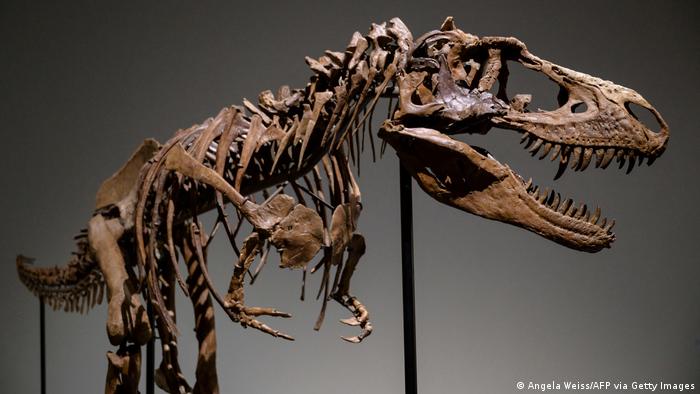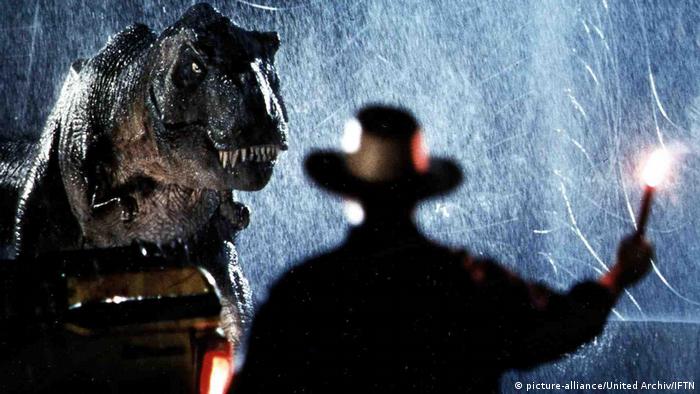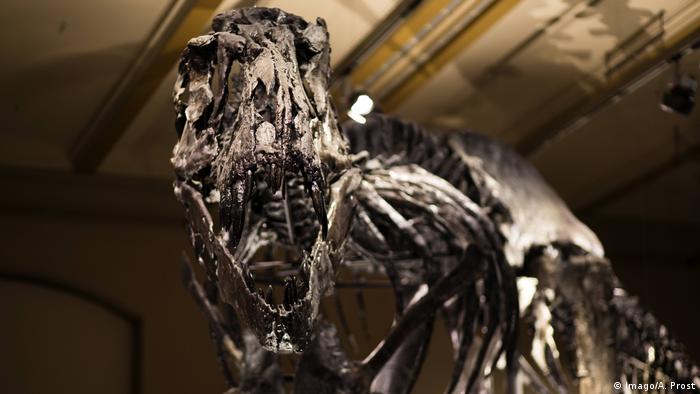Priceless prehistoric relics, like the Gorgosaurus skeleton selling for $6 million at auction this week, need to be kept clean and in good shape.

This T. rex-like Gorgosaurus skeleton went under the hammer for $6 million
The preservation and conservation of massive skeletons, from prehistoric dinosaurs to 19th century blue whales, is a mammoth task for natural history museums around the world.
These ancient remains have increasingly become hot-ticket items for private collectors — a T. rex related Gorgosaurus was auctioned by Sotheby's New York on Thursday for $6 million (€5.9 million) — which makes the work of cleaning and dusting these old bones all the more vital.
Leaf blowers and feather dusters
FEATHER DUSTERS SPREAD DUST, WE USE LAMBSWOOL (SYNTHETIC) OR MICROFIBRE TO PICK UP 99% OF THE DUST
"Fossilized bone will return to dust given enough exposure to the elements," wrote the Natural History Museum of Utah (NHMU) in a 2017 article titled "Dusting our Dirty Dinosaurs."
William Thomas, the exhibit preparator at the NHMU, which holds a large collection of Jurassic-era specimens, told DW that "the standing dinosaur skeletons get dusted about twice a year."
Comprising a mix of fossils and skeletal reconstructions, the standing dinosaur display includes a towering Barosaurus that rises over 9 meters (30 feet) off the ground, whose long neck helped it feed on plant matter from tall trees around 150 million years ago.
"Fossilized bone will return to dust given enough exposure to the elements," wrote the Natural History Museum of Utah (NHMU) in a 2017 article titled "Dusting our Dirty Dinosaurs."
William Thomas, the exhibit preparator at the NHMU, which holds a large collection of Jurassic-era specimens, told DW that "the standing dinosaur skeletons get dusted about twice a year."
Comprising a mix of fossils and skeletal reconstructions, the standing dinosaur display includes a towering Barosaurus that rises over 9 meters (30 feet) off the ground, whose long neck helped it feed on plant matter from tall trees around 150 million years ago.
"Our favorite dusting tool is a powerful leaf blower," Thomas explained, which is used in tandem with feather dusters attached to long poles and a compressed air cleaning device.
"We usually do a big dusting in June," he added, "and another big dusting in the winter when we do a test of our smoke evacuation system, which tends to send a big wind through the building and raises a lot of dust."
Thomas and his team scour the galleries daily for the occasional spider web, or damage caused by visitors.
"We have had to repair some broken-off pieces over the years," he said. "This is much easier with cast specimens than with fossilized bones."
Bug and beetle deep clean
At the Smithsonian National Museum of Natural History in Washington D. C., the public collection has been given a very thorough clean.
In the Department of Vertebrate Zoology, a colony of carnivorous dermestid beetles, which museum specialist John Ososky calls "super sanitation engineers," are used to remove the toughest tissue from bones.
"I have close to a million beetles voraciously cleaning away muscle and connective tissue from any specimens I give them," he said. While a small mammal like a mouse can be cleaned in a couple of hours, large mammals like whales can take many months.
BEASTS THAT COULD COME BACK FROM EXTINCTIONNo fear of a T-Rex sequelFive films on, Jurassic Park still has us captivated by the idea of humans coming face-to-face with our planet's most terrifying former inhabitants. But the fantasy of resurrecting a dinosaur from DNA in the belly of an amber-trapped mosquito is a long way from reality. Leading de-extinction scientists say making use of genetic material more than a million years old won't be possible.
A whale of a time
Five years ago, London's Natural History Museum unveiled a blue whale skeleton called "Hope" after a painstaking renovation.
A stranded whale found in 1891 in Ireland, the museum in South Kensington first displayed the skeleton in 1934. Taken down in 2015, conservationists worked for over three years preparing the 4.5-ton specimen with 221 bones to be displayed front-and-center in the museum.
In 2020, when the museum reopened after the initial COVID lockdowns, the conservation team again cleaned and dusted the huge blue whale skeleton. Over a two-day period, Hope was gently cleaned using soft brushes and vacuum cleaners, with the team also checking for any stress cracks in the bones.
More recently, the iconic blue whale at the New York Museum of Natural History — the largest model of the largest animal that has has ever lived on earth — received its nine-monthly clean. The entire 29 meter body of the whale has been getting a regular good dusting since it was first installed in 1969.
'Inspire wonder and capture imaginations'
Now, not only large museums but also private collectors will have to learn how to keep their prehistoric investments in pristine shape.
The Gorgosaurus sold at Sotheby's was a massive carnivore related to the Tyrannosaurus rex; it was at the top of the food chain 10 million years before its more famous cousin. The skeleton was discovered in 2018 in the US state of Montana and is nearly 3 meters tall and 7 meters long.
Most Gorgosaurus skeletons are in museum collections, making this the first available for private ownership, the auction house said.
"In my career, I have had the privilege of handling and selling many exceptional and unique objects, but few have the capacity to inspire wonder and capture imaginations quite like this unbelievable Gorgosaurus skeleton," Cassandra Hatton, Sotheby's global head of science and popular culture, said in a statement.
Back in May, a roughly 100 million-year-old Deinonychus antirrhopus dinosaur skeleton was auctioned in New York for about $12 million dollars; while in 2020 a skeleton of a T. rex known as "Stan" fetched over $30 million.
Many experts are critical of the auctioning of scientifically valuable skeletons, knowing that whoever shells out millions of dollars to own these relics will also have to hire a regular army of cleaners to ensure they don't deteriorate before their time.
BYE, BYE TRISTAN OTTO! THE KING OF THE DINOSAURS IS LEAVING BERLINA temporary farewellBefore leaving for Copenhagen, Berlin fans can once again celebrate the T. rex during a farewell weekend. But it is only a temporary farewell: Tristan Otto is scheduled to return to the German capital in 2021. Worldwide there are about 50 reconstructed specimens of Tyrannosaurus rex, mainly in the USA. Tristan Otto is the only original skeleton of a T. rex in Europe.


No comments:
Post a Comment